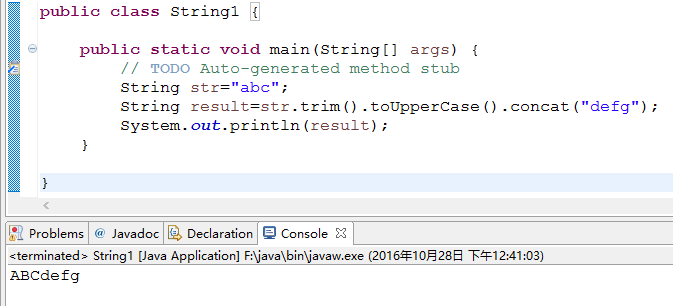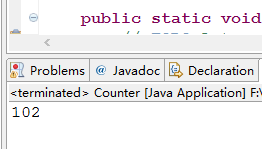作业一:请运行以下实例代码StringPool.java,查看其输出结果。如何解释这样的输出结果?从中你能总结出什么?

结论:在Java中,内容相同的字串常量(“Hello”)只保存一份以节约内存,所以s0,s1,s2实际上引用的是同一个对象。
编译器在编译s2一句时,会去掉“+”号,直接把两个字串连接起来得一个字串(“Hello”)。这种优化工作由Java编译器自动完成。
当直接使用new关键字创建字符串对象时,虽然值一致(都是“Hello”),但仍然是两个独立的对象。
作业二:再看……
为什么会有上述的输出结果?从中你又能总结出什么?

结论:给字串变量赋值意味着:两个变量(s1,s2)现在引用同一个字符串对象“a”!
String对象的内容是只读的,使用“+”修改s1变量的值,实际上是得到了一个新的字符串对象,其内容为“ab”,它与原先s1所引用的对象”a”无关,所以,s1==s2返回false;
代码中的“ab”字符串是一个常量,它所引用的字符串与s1所引用的“ab”对象无关。
String.equals()方法可以比较两个字符串的内容。
作业三:请查看String.equals()方法的实现代码,注意学习其实现方法。
(1)程序代码:
public class StringEquals {
public static void main(String[] args) {
String s1=new String("Hello");
String s2=new String("Hello");
System.out.println(s1==s2);
System.out.println(s1.equals(s2));
String s3="Hello";
String s4="Hello";
System.out.println(s3==s4);
System.out.println(s3.equals(s4));
}
}
运行结果截图:

课后作业四:String类的方法可以连续调用:
String str="abc";
String result=str.trim().toUpperCase().concat("defg");
请阅读JDK中String类上述方法的源码,模仿其编程方式,编写一个MyCounter类,它的方法也支持上述的“级联”调用特性,其调用示例为:
MyCounter counter1=new MyCounter(1);
MyCounter counter2=counter1.increase(100).decrease(2).increase(3);
程序源代码:
public class String1 {
public static void main(String[] args) {
// TODO Auto-generated method stub
String str="abc";
String result=str.trim().toUpperCase().concat("defg");
System.out.println(result);
}
}

程序源代码:
class MyCounter
{
int data;
public void set(int d)
{
data=d;
}
public MyCounter increase(int i)
{
MyCounter a=new MyCounter();
a.data=data+i;
return a;
}
public MyCounter decrease(int d)
{
MyCounter a=new MyCounter();
a.data=data-d;
return a;
}
}
public class Counter {
public static void main(String[] args) {
// TODO Auto-generated method stub
MyCounter counter1=new MyCounter();
MyCounter counter2=new MyCounter();
counter1.set(1);
counter2=counter1.increase(100).decrease(2).increase(3);
System.out.println(counter2.data);
}
}
运行结果截图:、

课后作业五:五.课后作业之字串加密、动手动脑之String.equals()方法、整理String类的Length()、charAt()、 getChars()、replace()、 toUpperCase()、 toLowerCase()、trim()、toCharArray()使用说明。
1.String.equals()方法:比较的是两个字符串的内容,与之区分的是“==”(判断对象的值和地址)。
2.Length():获取字符串的长度。
3.charAt():获取指定位置的字符(其中下标从0开始)。
4. getChars():获取从指定位置起的子串复制到字符数组中。
5.replace():子串替换。
6.toUpperCase():全部字符变为大写,返回新字符串。
7. toLowerCase():全部字符变为小写,返回新字符串。
8.trim():去除头尾空格。
9.toCharArray():将字符串对象转换为字符数组。